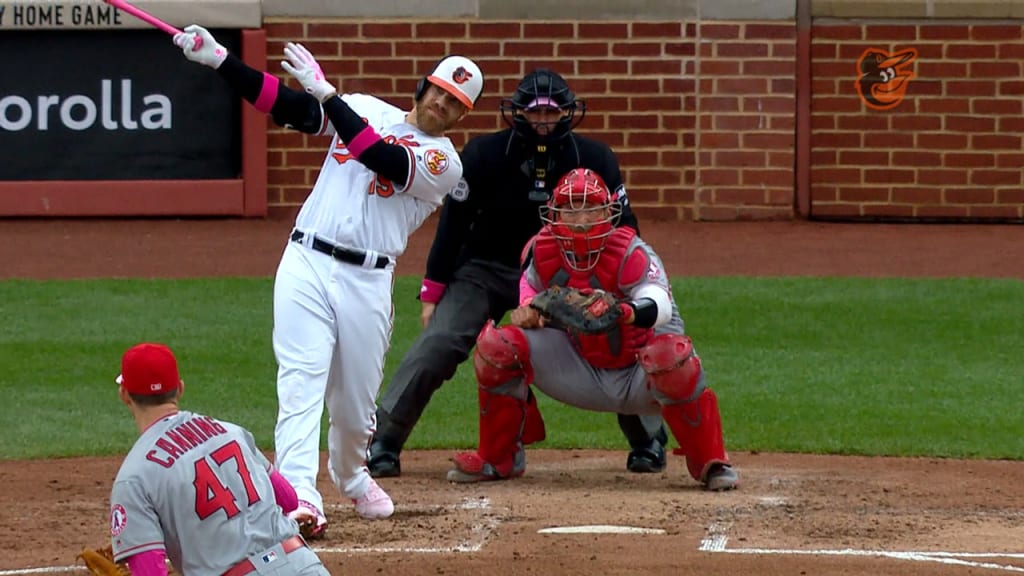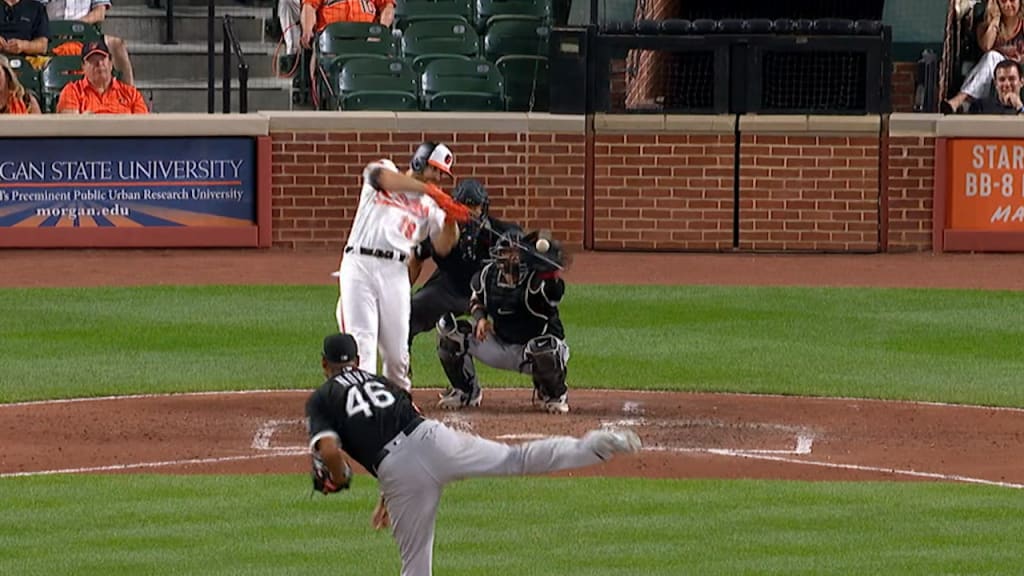Chris Davis could be an All-Star ... really
This browser does not support the video element.
Chris Davis started the 2019 season without a hit in his first 38 plate appearances, which came after he ended the 2018 season without a hit in his final 24 appearances, which all together made for a Major League record 62 consecutive plate appearances without a hit. Coming on the heels of a 2018 where he'd hit all of .168/.243/.296, and given that the Orioles had turned over their front office after a disastrous 47-115 season, it seemed reasonable to wonder how much longer Davis would even be an Oriole.
A month later, we come bearing what probably sounds like an insane question, one originally posed to us via Twitter: What would have to happen to make Davis an All-Star this year?
Wait! Don't go. There's something to this. The reason we can even have this conversation is that since Davis got that first hit to break the streak back on April 13, one of three that day, he's been... really quite good, actually.
Davis, since April 13
76 plate appearances
.279/.355/.544
.899 OPS
140 wRC+ (where 100 is league-average)
That's not just "good compared to a guy who couldn't buy a hit," it's objectively good. Since April 13, there have been 228 batters to step to the plate 75 times, and Davis' line is 44th-best, or better than about 80 percent of the rest of baseball. He's been better than Jose Abreu, Willson Contreras, Freddie Freeman, and Tommy Pham. He's been really, really good.
It's not just his "luck evening out," either. His Weighted On-Base Average (think OBP, except with more credit for extra base hits than walks or singles) since April 13 is .384, while the Major League average in that time is .318. That's a little better than his Expected wOBA of .354, which attempts to remove the effects of ballpark and defense to just look at quality of and amount of contact, but even the .354 is strong, better than about 70 percent of other hitters.
When Davis had his monster 2013, hitting 53 homers, his wOBA was .421. When he crushed 47 homers in 2015, it was .390. Since April 13, as we said, it's .384. If he'd done that in a calendar month rather than split over April/May, it would have been his best month since June 2016.
There's a truly enormous difference between doing it for a full season and for a few weeks, obviously. But the point is that over the last month, Davis is looking a lot more like he used to, for the first time in a long while, in a way it was no longer clear he could ever do again.
How? That part is a little more complicated, but a lot of it is about contact, because Davis whiffed 42 percent of the time this year through April 12, and that's down to a far more manageable 30 percent since. On the season, he's still hitting the ball hard when he hits it; his hard-hit rate of 50 percent is in the 92nd percentile, similar to Nelson Cruz, Martinez and Hoskins.
This browser does not support the video element.
Davis also made vague allusions to changes in his posture and bat path, as he told MLB.com's Joe Trezza last month:
“I’m in a better position to attack the ball now,” Davis said. “The bat path is more direct, there is less wasted movement, and I feel like I’m starting to see a little more of a return at the end of the day.”
OK, so that's the good news: Davis has been performing a lot better, and he's earned it with skill, not luck. So... what about that All-Star question?
The reason we're even asking this, aside from Davis' resurgence, is mainly that it would be an absolutely incredible story for a player to go from record-setting ineffectiveness to making the All-Star team in the course of the same season. But it's also about the composition both of the Orioles roster and the American League as a whole. Let's stipulate first that Davis has to keep hitting like he has -- nothing matters if he can't do that -- and figure out how this would work.
1) The competition in Baltimore
First, let's take a look at the Orioles, figuring a rebuilding team in last place that can no longer boast stars like Manny Machado, Adam Jones, and Zack Britton is probably getting only the mandatory single representative. Setting aside Davis, there are two Baltimore hitters we'll say are having strong seasons, and two pitchers.
Trey Mancini -- .308/.355/.545, 141 OPS+
Dwight Smith Jr. -- .271/.317/.484, 114 OPS+
John Means -- 2.33 ERA in 40 2/3 innings
Mychal Givens -- 2.89 ERA in 18 2/3 innings
That's really it, which isn't surprising given the current status of the Orioles. If the selections took place today, then Mancini would probably be the Baltimore choice, because he's gone from being a power-only bat -- last year, he had 24 homers but only a .299 on-base percentage -- to a good overall hitter, posting that .308/.355/.545 line so far.
Mancini, however, faces two problems. First, he missed several days at the end of April with a bruised index finger suffered swinging at a Jose Berrios fastball that bore inside on him. While he avoided a fracture or a trip to the injured list, he's been ineffective since returning, hitting just .196/.229/.370. It's unclear whether that's specifically related to the finger, but it's far less than he was doing before, and it's worth keeping in mind if it affects him going forward.
This browser does not support the video element.
Mancini's second problem? It's the same one Smith would have, and Means.
2) The AL is loaded in the outfield and on the mound...
Last year, the AL took eight outfielders on their roster, and a quick look at AL outfielders this year shows far more than that who are worthy. Mike Trout and George Springer seem like slam dunks, and reigning Most Valuable Player Mookie Betts probably gets voted in despite starting off slowly. Michael Brantley is having a great season, and so are Tommy Pham and Joey Gallo. Whit Merrifield and Alex Gordon will have cases, and so will Byron Buxton, Mitch Haniger, Josh Reddick, Martinez, and Avisail Garcia.
If Mancini, who pairs a below-average glove with his strong bat, is going to have a hard time getting past that group, it might go double for the lesser-known Smith.
Meanwhile, Means has been a revelation for the O's this year, and Givens has been fine in far fewer innings, but we should hardly need to remind you of the pitching depth in the league. (We will anyway: think of Justin Verlander, Trevor Bauer, Gerrit Cole, Mike Minor, Matthew Boyd, Tyler Glasnow, Blake Snell, Charlie Morton, Jose Berrios, Marcus Stroman, and a seemingly endless stream of relievers like Ryan Pressly, Roberto Osuna, Blake Treinen, Matt Barnes, Shane Greene, Jose Alvarado, Brad Hand, and so on.)
So, let's say that Mancini either falls off or just can't break into the outfield. Let's say that Means either can't maintain his surprising performance or there's just too much trouble fitting him onto a deep AL pitching staff.
There's an easier path onto the roster. It comes at a surprising position.
3) ... but not so much at first base.
This is the key, here, aside from the earlier stipulation that Davis keeps hitting: The group of first basemen in the AL is not what it used to be. In 2018, AL first basemen had a .316 wOBA, the lowest number in nearly a century of baseball dating back to the dawn of the live ball era in 1920. The second lowest number? It's 2019.
That's on Davis to some extent, sure, but he doesn't carry this burden alone. Look what's happened to the slugging AL first basemen from earlier this decade, shall we? Miguel Cabrera and Albert Pujols are fractions of their previous greatness. Reliable bats like Paul Konerko, Mark Teixeira, Mike Napoli, and Prince Fielder are long retired, while Eric Hosmer is now in the National League and Joey Gallo (and Mancini, and Mark Trumbo) plays the outfield.
Look at this year's competition at first base. Mitch Moreland, Luke Voit, Edwin Encarnacion, and Jose Abreu have all had strong seasons, but they're all on teams with arguably more deserving candidates anyway. (Yandy Diaz, listed there, has played far more at third base for the Rays and would likely not be considered a first baseman for All-Star purposes.)
Those seasons are good, as is Logan Forsythe's, though none is quite off to a dominating Trout-esque start. If Davis keeps hitting as he has since April 13 -- a huge "if", we know -- his season line on July 1 would look something like .250/.325/.500, even with that oh-for-the-first-two-weeks built in. That might be good enough.
4) Don't forget about the player vote.
Here's the other consideration: The structure of how teams are selected. The fans select the eight non-pitching starters on each team. That won't be Davis. Then the players step in, and this is important. AL players get to select 17 backups, split into eight pitchers and nine position players -- one backup at each of the eight spots, and a DH.
Player votes tend to focus on established stars and traditional stats more than advanced ones, so it's possible that Voit and Moreland and their low batting averages (.242 and .230, respectively) may suffer here, despite strong supporting numbers. (Yes, Davis is hitting .188 right now, but remember that we're assuming he keeps on raking.) Davis, for all his struggles, remains a big, established well-known name.
If he doesn't get in via the players, then it's up to the Commissioner's Office, who selects the final five spots -- in the AL, that's four pitchers and one position player -- and mainly uses those to ensure that any team without representation gets one. If no Oriole has been picked yet, as seems possible this is likely how they would select Mancini, Smith, Givens, Means -- or Davis.
This is, it should go without saying, a fun trip through fantasy land. It's incredibly unlikely to happen. It's not impossible, not with the way Davis has been hitting over the last month, and with the way that the Baltimore and AL rosters could shake out. That alone is worth discussing. A few weeks back, Davis was the guy who couldn't get a hit. What a difference a few weeks has made.

